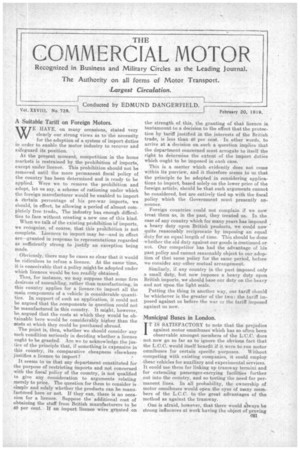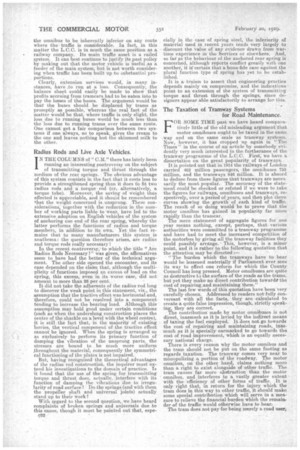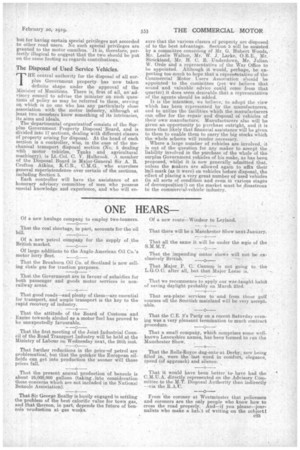A Suitable Tariff on Foreign Motors.
Page 1

Page 2

Page 3

If you've noticed an error in this article please click here to report it so we can fix it.
'WE HAVE, on many occasions, stated very clearly our strong views as to the necessity for the adoption of a system of import duties in order to enable the motor industry to recover and 6feguard its position.
At the prel,t,ent moment, competition in the home markets is restrained by the prohibition of imports, except under licence. This prohibition should not be removed until the more permanent fiscal policy of the country has been determined and is ready to be applied. Were we to remove the prohibition and adopt, let us say, a scheme of rationing under which the foreign manufacturer would be enabled to import a Certain percentage of his pre-war imports, we should, in effect, be allowing a period of almost completely free trade., The industry has enough difficulties to face without creating a new one of this kind. When we talk of the existing prohibition :of imports, we recognize, of course, that this prohibition is not complete. Licences to import may be—and in effect are—granted in response to representations regarded as sufficiently strong to justify an exception being made.
Obviously, there may be cases so clear that it would be ridiculous to refuse a licence. At the same time, it is conceivable that a policy might be adopted under which licences would be too readily obtained. Thus, for instance, we may suppose that some firm desirous of assembling, rather than manufacturing, in this country applies for a licence to import all the main components of a vehicle in considerable quantities. In support of such an application, it could not be argued that the components in question could not ' be manufactured in this country. It might, however, be.. argued that the costs at which they would be obtainable here would be considerably higher than the oests at which they could be purchased abroad. The point is, then, whether we should consider any such condition seriously in deciding whether a licence ought to be granted. Are we to acknowledge the justice of the principle that, if something is expensive in this country, its comparative cheapness ersewhere justifies a licence to import? '
It seems to us that any department constituted for the purpose of restricting imports and not concerned with the fiscal policy of:the country, is not qualified to give any consideration to arguments relating merely to price. The question for them to consider is simply and solely whether the products can be manufactiired here or not. If they can, there is no occasion for a licence. Suppose the additional cost of obtaining the stuff from British manufacturers to be 40 per cent. If an import licence were granted on the strength of this, the granting of that licence is tantamount to a decision to the effect that the protection by tariff justified in the interests of the British , trade, is less than .40 per cent: • In other words, to arrive at a decision on such a question implies that the department concerned must arrogate to itself the right to determine the extent of the import duties which ought to be imposed in each case.
This is a matter which evidently does not come within its purview, and it therefore seems to us that the principle to be adopted-in considering applications to import, based solely on the lower price of the foreign article, should be that such arguments cannot be considered, but are entirely tied up with the fiscal spolicy which the Government must presently announce.
Foreign countries could not complain if we now treat them as, in the past, they treated us. In the case of any country which for many years has imposed a heavy duty upon British products, we could now quite reasonably reciprocate by imposing an equal duty for an equal length of time. This should be done whether the old duty against our goods is continued or not. Our competitor has had the advantage of his past policy and cannot reasonably object to our adoption of that same policy for the same period, before we consider any other mutual arrangement.
Similarly, if any country in the past imposed only a small duty, but now imposes a heavy duty upon British imports, we should base our duty on the heavy and not upon the light scale.
Putting the thing in another way, our tariff should be. whichever is the greater of the two : the tariff imposed against us before the war or the tariff imposed against us now.
Municipal Buses in London.
IT IS SATISFACTORY to note that the prejudice against motor omnibuses which has so often been observable amongst members of the L.C.C. does not.now go so far as to ignore the obvious fact that the L.C.C. would itself benefit if it were to run motor omnibuses for certain specific purposes. Without competing with existing companies, it could employ these vehicles for auxiliary and experimental services. It could use them for linking up tramway termini and for extending passenger-carrying facilities further out into the country, and so testing the need for permanent lines. In all probability, the ownership of motor omnibuses would open the eyes of many members of the L.C.C. to the great advantages of the method as against the tramway. • One is afraid, however, that there would always be strong influences at work having the object of proving 021
the omnibus to be inherently inferior on any route where the traffic is considerable. In fact i , n this matter the L.C.C. is in much the same position as a railway company. Its main traffic asset is a railed system. It can best. continue to jastify its past policy by making out that the motor vehicle is useful as a feeder of the main system, but, is not worth considering when traffic has been built up to substantial pro portions. .
Clearly, extension services -would, in many instances, have to run at a loss. Consequently, the balance sheet could easily be made to allow that profits accruing from tramcars had to be eaten into to pay the losses of the buses. The argument would be that the buses should be displaced by trams as promptly as possible, whereas the real fact of the matter would be that, where traffic is only slight, the loss due to running buses would be much less than the loss due to running tra,ms over the same ratite. One cannot get a fair comparison between two systems if one always, so to speak, gives the cream to the one and leaves nothing but the skimmed milk to the other.
Radius Rods and Live Axle Vehicles.
IN THE COLUMNS of " C.M." there has lately been running an interesting controversy on the subject of transmitting torque and thrust through the medium of the rear springs. The obvious advantage of this system consists in the fact that it costs less to provide a strengthened spring than it does to fit two radius rods and a torque rod (or, alternatively, a torque tube). Moreover, the saving of weight thus effected is appreciable, and it should be remembered that the weight concerned is . unsprung. These considerations, together with the reduction in the number of working parts liable to wear, have led to the extensive adoption on English vehicles of the system of anchoring one end of the rear spring, whereby the latter performs the functions of radius and torque members, in addition to its own. Yet the fact remains that to many manufacturers this system is anathema: the question therefore arises, are radius and torque rods really necessary?
In the recent controversy,to which the title "Are Radius Rods Necessary ?" was given, the affirmatives seem to have had the better of the technical argument. The other side opened the encounter, and its case depended on the claim that, although the multiplicity of functions imposed an excess of load on the spring, this excess, even in its worse case, did not amount to more than 28 per cent. • It did not take the adherents of the radius rod long to discover the weak point in this statement, viz., the assumption that the traetive effect was horizontal and, therefore, could not be resolved into a component tending to increase the bearing load. Although this assumption may hold good under certain conditions (such as when the underslung construction places the centre of the shackle on a level with the wheel centre), it is still the fact that, in the majority of existing lorries, the vertical component of the tractive effect cannot be ignored. When the spring is arranged so as exclusively to perform its primary function of damping the vibration of the unsprung parts, the stresses are bound to be much more uniform throughout the material, consequently the symmetrical functioning of the plates is not impaired. But, having recognized the theoretical advantages of the radius rod construction, the inquirer must extend his investigations to the domain of practice. Is it found that the use of the spring for transmitting torque and thrust does. actually, interfere with its function of damning the vibrations due to irregularity of road surface ? Do the springs (and with them the propeller shaft and universal joints) actually stand up to their work ? With r,pgard to the second question, we have heard complaints of broken springs and universals due to this cause, though it must be pointed out that, espe e22 eially in the case of spring steel, the inferiority of material used in .recent years tends very largely to discount the value of any evidence drawn from wartime experience in the Services or elsewhere. And, so far as the behaviour of the anchored rear spring is coneerhed, although reports conflict greatly with one another, it is certain that a bona-fide case against the plural function type of spring has yet to be established.
It is a. truism to assert that engineering practice depends mainly on compromise, and the indicationspoint to an extension of the system of transmitting torque and thrust through the springs, since designers appear able satisfactorily to arrange for this.
TheTaxation of Tramway Systems for Road Maintenance. FOR SOME TIME pastwe have heard comparetivelv little of the old misleading argument that motor omnibuses ought to be taxed in the same way and on the same 'scale aS tramway systems. Now, however, it has cropped up again in "The Times " in the course of an article by somebody evidentlyvery much interested in the furtherance -of the tramway programme of the Lao. First, we have a dissertation on the great popularity of tramways. It is pointed out that iii i14 the railways of London earned • 462 million pal3Rellgen, the omnibuses 753 Million. and the tramways 846 million. It is absurd to deduce from these figures that tramways are necessarily the most popular. The accuracy of the statenient could be checked or refuted if we were to take the figures for railways, omnibusesand tramways, respectively,, over a period of years, and then plot three curves showing the growth of each kind of traffic. The result of so doing would be to prove that the motor omnibus has gained in popularity far more raptidly than the tramcar.
The more statement of aggregate figures for one year means nothing, except, perhaps, that various authorities were committed to a tramway programme and have had to meet the increased corn-petition of the motorbus by giving all the tramway facilities they could possibly arrange. This, however, is a minor point, and it us rather to the following quotation that the attention may be directed :— " The burden which the tramways 'have to bear would be lessened materially if Parliament ever sees its way to effect one reform for which the County Council has long pressed. Motor omnibuses are quiteas destructive to -the surface of the roads as the trains, but yet they make no direct contribution towards' the cost of repairing' and -maintaining them." The last few words of this quotation have been very carefully chosen. Addressed to readers not-fully conversant with all the facts, they are calculated to create a quite false impression, though, strictly speaking, they are correct.
The contribution made by motor omnibuses is not direct, inasmuch as it is levied by the indirect means of taxing the fuel employed. It does not .go towards the cost of repairing and maintaining roads, inasmuch as it is specially earmarked to go towards the cost of road improvement, which is an equally necessary national charge.
There is every reason why the motor omnibus and the tram should not be put on the same footing as regards taxation. The tramway comes very near to monopolizing a portion of the roadway. The motor omnibus, on the other hand, claims nothing more than a right to exist alongside of other traffic. The tram causes far more obstruction than the moter omnibus, and interferes to a vastly greater extent with the 'efficiency of other forms of traffic. It is only right that, in return for the injury which the tram does in this way to other traffic, it should make some special contribution which will serve in a mesa sure to relieve the financial burden which the remainder of the traffic would otherwise have to bear,
The tram does not pay for being merely a road user,
but for having certain special privileges not accorded to other road users. No such special privileges are granted to the motor omnibus. It is, therefore, perfectly illogical to suggest that the two should be put on the same footing as regards contributions.
The Disposal of Used Service Vehicles.
THE central authority for the disposal of all surplus Government property has now taken definite shape under the approval of the Minister of Munitions. There is, first of all, an advisory council to advise the minister on Such questions of policy as may be referred to them, serving on which JE1 no one who has any Barticularly close association with the motor industry, although at least two members know something of its intricacies, its aims and ideals. The departmental organization?' consists of the Surplus Government 'Property Disposal 'Board, and is divided into 17 sections, dealing with different classes of property arising for disposal. At the head of each section is a controller, who, in the case of the mechanical transport disposal section (No. 5 dealing with motor vehicles, Tanks and agricultural machinery), is Lt.-Col. C. V. Holbrook. A member of the 'Disposal Beard is Major-General Sir A. R. Crofton Atkins, K.C.B., C.M.G., who exercises general superintendence over certain of the sections, including Section 5.
Each controller will have the assistance of an honorary advisory committee of men who possess special knowledge and experience, and who will en
sure that the various classes of property are disposed of to the best advantage. Section 5 will be assisted by a committee consisting of Mr. G. Hubert Woods, Mr. Leslie Walton, Mr. W. J.',Larke, 0.B.E., Mr. Strickland, Mr. H. C. B. Underdown_, Mr. Julian W. Orde and a representative of the War Office to be appointed. Although it would, perhaps, be expecting too much to hope that a representative of the Commercial Motor Users Association should be appointed, to the committee (yet we believe that sound and valuable advice could come from that quarter) it does seem desirable that a representative of the agents should be added.
It is the intention, we believe, to adopt the view which has been represented by the manufacturers, and to utilize the facilities which the manufacturers can offer for the repair and disposal of vehicles of their own manufacture. Manufacturers also will be given an opportunity to purchase outright, and it is more than likely that financial assistance will be given to them to enable them to carry the big stocks which the whole scheme will render necessary.
Where a large number of vehicles are involved, it is out of the question for any maker to accept the liability involved in the purchase of the whole of the surplus Government vehicles of his make, as has been proposed, whilst it is now generally admitted that, unless the rakers are allowed again to affix their hall-mark (as it were) on vehicles before disposal, the effect of placing a very great number of used vehicles (in all sorts of condition and even in various stages of decomposition!) on the market Must be disastrous to the commercial-vehicle industry.






















